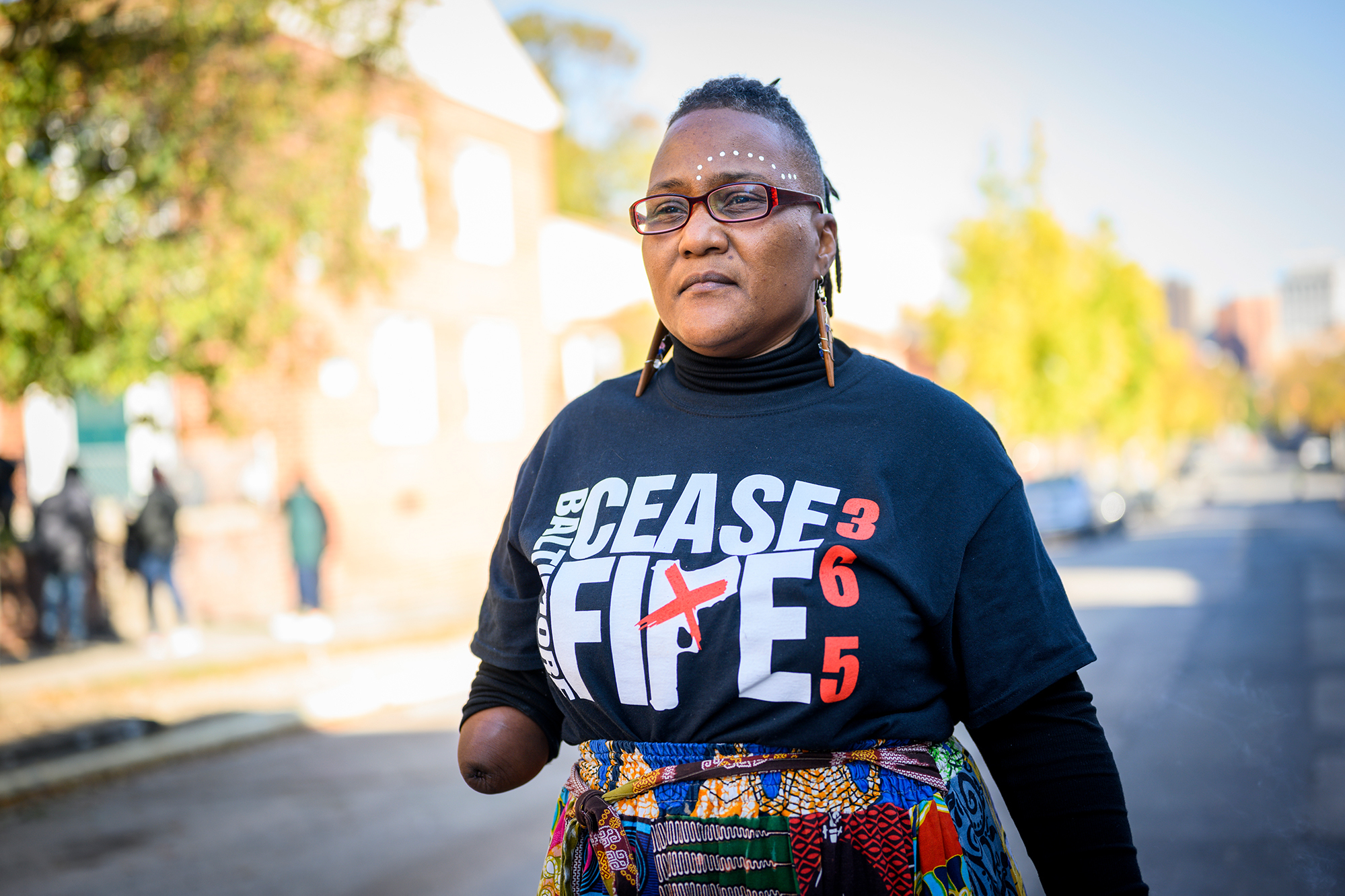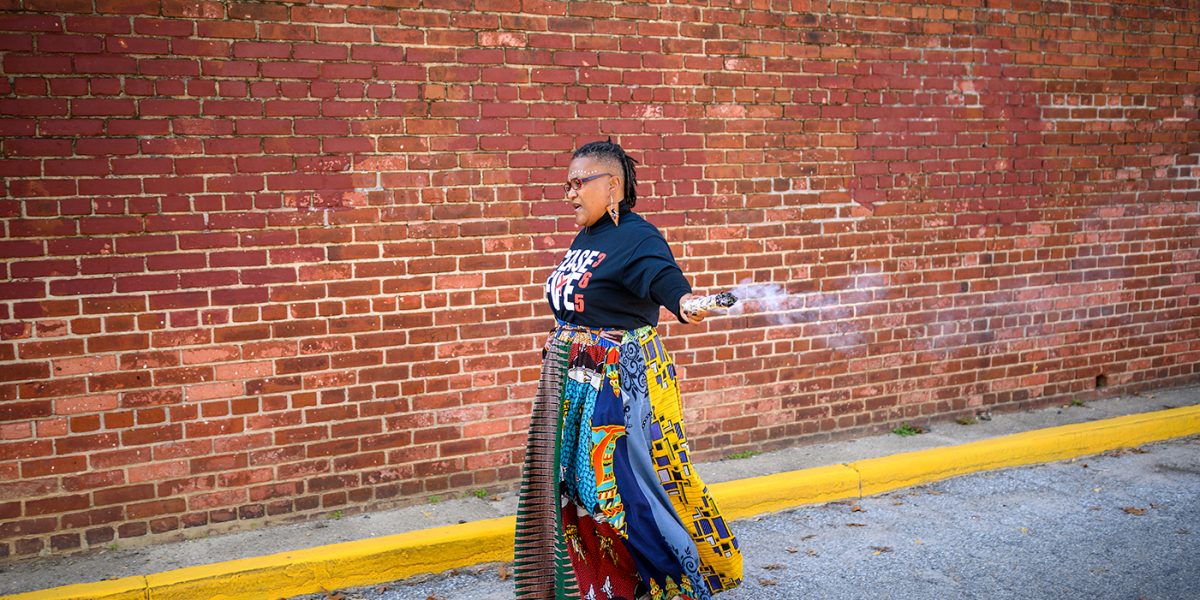GameChangers
Q&A with Erricka Bridgeford
Co-Founder, Baltimore Ceasefire
In 2017, as a reaction to the city’s alarming homicide rate, Erricka Bridgeford co-created Baltimore Ceasefire weekends—three designated days during which city residents committed to putting down their weapons, with the hope of reducing violence. But even before Ceasefire, Bridgeford, who works as director of training for Community Mediation Maryland, assisted in passage of a 2015 bill to provide resources to families of homicide victims, as well as the 2013 repeal of the death penalty. Last year, the short film, SAGE, which premiered at the Maryland Film Festival, documented Bridgeford’s ritual of burning sage at the sites in the city where homicides have been committed.

How does Ceasefire work?
We’ve said from the beginning if people are given an opportunity to do something together, that if you have as many people as possible involved, it becomes peer pressure. You don’t want to be that guy who kills somebody while the whole city is having a sacred weekend to celebrate life together.
This is why outreach before the weekend is really important. We’re saying to everyone, be as peaceful as you can and think of ways you can be peaceful on purpose. When people know it’s Ceasefire weekend, they have a conversation with someone, put a flyer in their hand, put a poster in their window.
Part of the reason you started this was that your brother was killed in 2007. Tell us about that.
My brother was two and a half years younger than me. He was my first sibling, so we were very close. Losing him felt like the end of my world. I was working at Community Mediation of Maryland at the time. I found out he got killed when I was in the middle of teaching a mediation training to the Office of the Public Defender in Baltimore. I was in bad shape for about six months.
What’s your biggest success story?
Back in February 2018, the Ceasefire weekend started a stretch of 11 and a half days when nobody got killed. The city hadn’t gone that long without a murder since March of 2014. Instead of trying to guess, we went to the streets and had conversations with people in some of the most violent areas of the city. After the weekend was over, we kept saying, “Oh, my goodness, it’s day four now, it’s day five.” It became a thing and, by day seven, the media had picked it up, so people were having that conversation: “I don’t want to be the one who breaks that streak right now, Baltimore is doing good.”
How has Ceasefire grown?
There are two Ceasefire Charter schools—Creative City and Lillie May Carroll Jackson and we’re working on Frederick Douglass High School—which are used for education and training programs. We’ve trained 30 Ceasefire ambassadors, both youth and adults, who represent the movement. Right now, we’re excited about our ability to get out our branding and messages. Around the city, you’ll see Ceasefire messages on buses and subways and also billboards.
It sounds like you’re reaching a lot of people.
I thought it was going to take years to get the kind of participation and buy-in that we’ve gotten in just two years. I’m completely blown away by it. Also, research shows there’s up to 66 percent fewer shootings on those three days, and the violence doesn’t immediately spike after the Ceasefire weekend. That’s always a big question: Are people just waiting till after the Ceasefire? Even the following weekend, violence doesn’t go up.
How did people resolve differences without firearms?
When people had conflict with each other, they’d go to whoever was their leader—whether it was their gang leader or someone they respected in the neighborhood. They’d say, “Look, I have a beef with so-and-so, but I know we have this thing going in Baltimore right now and I don’t want to be that guy that messes it up.” So they would brainstorm and come up with creative ways to resolve the conflict. They’d block off a lot or an abandoned field where people could come. Whoever had this conflict, they were going to come and have a fight and after the fight was over, nobody could come back shooting, nobody could keep talking about it and antagonize the other person. Anyone who came to see it had to check their gun with someone at the gate—yes, this really happened.
People look at shooters as different from themselves. The truth of the matter is that if most people had a gun in their hand at the wrong time, many more of us would have shot somebody and never even remembered pulling the trigger. Conflict often escalates—and it’s easier to buy a gun in Baltimore than find fresh fruits and vegetables.
Does your background in mediation help with your advocacy?
Mediation skills give me the ability to understand people’s hopelessness and make sure people feel heard, but it doesn’t give me the wherewithal to keep navigating murder. What helps me with that is having faced so much murder myself and doing my own healing work around my own trauma.
I was born with one hand, so society treats me like I’m broken, and I’ve watched people treat Baltimore like it’s broken. These different things are identity markers for me: Having one hand, being Black, being a woman, growing up in poverty, having to face murder so much. These are my experiences and give me this wide-ranging emotional and spiritual wherewithal to navigate and engage with murder.
